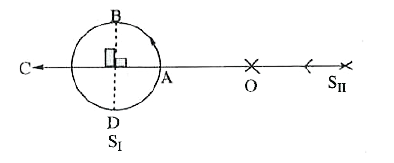SN1 is observed in

R−OH+SOCl2→
R−Xalc.KOH−−−−−→
ROH+HX→
The correct Answer is:A
NA
Similar Questions
As shown in the figure two sources producing sound Sr and Sn (velocity of sound 360 m/sec) each producing sound of frequency 200 Hz. S1 is rotating anti clock wise where as Sn is approaching observer O each with a speed 10 m/sec. (neglect radius of circular path of S1), then calculate

If wind is blowing from right to left with a speed 10 m/sec and observer is at rest find the number of beats received by observer when S1 is at A. (nearly)
View SolutionConsider a source of sound S, and an observer P. The source emits sound of frequency N0. The frequency observed by P is found to be N1 if P approaches S at a speed v and S is stationary; N2 if S approaches P at a speed v and P is stationary and N3 if each of P and S has speed v/2 towards one another
View Solution
Knowledge Check
In the above example the angular velocity of S2 as actually observed by an astronaut in S1 is -
A3×10−4B3×1023C3×10−6D3×10−7Rate of SN1 reaction is :
 AS>Q>R>PBS>R>P>QCP>Q>R>SDS>R>Q>P
AS>Q>R>PBS>R>P>QCP>Q>R>SDS>R>Q>P
Two different sound sources s1ands2 have frequencies ratio 1:2. Source s, is approaching towards an observer and s2 is receding from the same observer. Speeds of both s1ands2 are the same and equal to v. speed of sound in air in 300 m/s. If no beats are heard by the observer the value of V is 1
View SolutionA vehicle, with a horn of frequency n is moving with a velocity of 30 m/s in a direction perpendicular to the straight line joining the observer and the vehicle. The observer perceives the sound to have a frequency n+n1. Then (if the sound velocity in air is 300 m/s)
View SolutionA vehicle , with a horn of frequency n is moving with a velocity of 30m/s in a direction prependicular to the straight line joining the observer and the vehicle . The observer perceives the sound to have a grequency (n+n1) . If the sound velocity in air is 330m/s , then
View SolutionWhat is an SN1 mechanism ? Give an example of a reaction following an SN1mechanism and explain why the mechanism is considered to be SN1.
View SolutionIn a series of 2n observations, half of them equal a end remaining half equal −a. If the S.D. of the observations is 2, then |a| equals
View SolutionLet S1,S2,S3, …. Are squares such that for each n≥1, The length of the side of Sn is equal to length of diagonal of Sn+1. If the length of the side S1 is 10 cm then for what value of n, the area of Sn is less than 1 sq.cm.
View Solution
